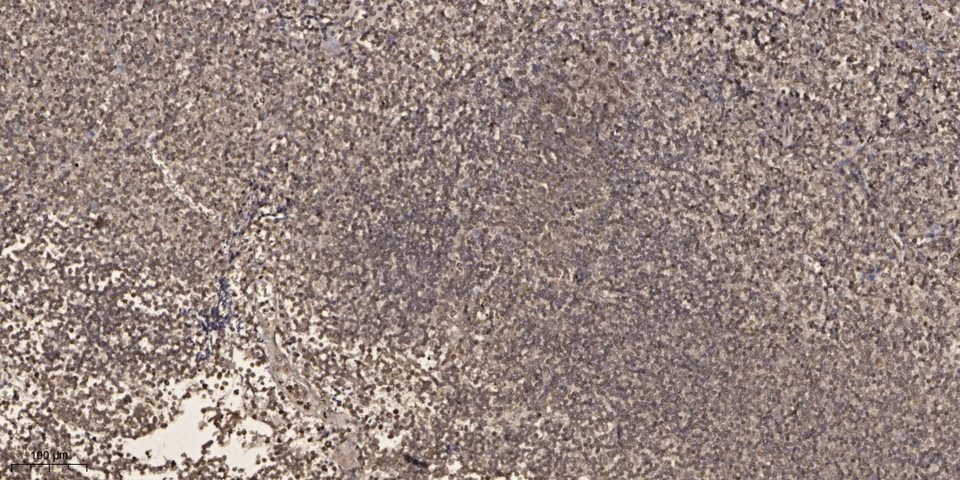产品名称
SP-100 Rabbit Polyclonal Antibody
别名
SP100; Nuclear autoantigen Sp-100; Lysp100b; Nuclear dot-associated Sp100 protein; Speckled 100 kDa
蛋白名称
Nuclear autoantigen Sp-100
存储缓冲液
Liquid in PBS containing 50% glycerol, 0.5% BSA and 0.02% New type preservative N.
Human Gene Link
http://www.ncbi.nlm.nih.gov/sites/entrez?db=gene&term=6672
Human Swissprot No.
P23497
Human Swissprot Link
http://www.uniprot.org/uniprotkb/P23497/entry
Mouse Swissprot No.
O35892
Mouse Swissprot Link
http://www.uniprot.org/uniprot/O35892
免疫原
Synthesized peptide derived from SP-100 . at AA range: 250-330
特异性
SP-100 Polyclonal Antibody detects endogenous levels of SP-100 protein.
稀释度
WB 1:500 - 1:2000. IHC 1:100 - 1:300. ELISA: 1:40000.. IF 1:50-200
宿主
Polyclonal, Rabbit,IgG
背景介绍
This gene encodes a subnuclear organelle and major component of the PML (promyelocytic leukemia)-SP100 nuclear bodies. PML and SP100 are covalently modified by the SUMO-1 modifier, which is considered crucial to nuclear body interactions. The encoded protein binds heterochromatin proteins and is thought to play a role in tumorigenesis, immunity, and gene regulation. Alternatively spliced variants have been identified for this gene; one of which encodes a high-mobility group protein. [provided by RefSeq, Aug 2011],
组织表达
Widely expressed. Sp100-B is expressed only in spleen, tonsil, thymus, mature B-cell line and some T-cell line, but not in brain, liver, muscle or non-lymphoid cell lines.
细胞定位
Nucleus. Nucleus, PML body . Cytoplasm. Differences in the subnuclear localization of the different isoforms seem to exist and may also be cell cycle- and interferon-dependent. Accumulates in the cytoplasm upon FAS activation.; [Isoform Sp100-C]: Nucleus . Forms a reticulate or track-like nuclear pattern with denser concentrations at the nuclear lamina and surrounding the nucleoli, a pattern reminiscent of heterochromatin-rich regions according to PubMed:11313457.
功能
disease:This antigen is recognized by autoantibodies from patients with primary biliary cirrhosis (PBC).,domain:Contains one Pro-Xaa-Val-Xaa-Leu (PxVxL) motif, which is required for interaction with chromoshadow domains. This motif requires additional residues -7, -6, +4 and +5 of the central Val which contact the chromoshadow domain.,domain:The HSR domain is important for the nuclear body targeting as well as for the dimerization.,function:May play a role in the control of gene expression.,induction:By interferon.,miscellaneous:The major isoform Sp100-A, has a calculated MW of 54 kDa, but exhibits aberrant electrophoretic mobilities, with an apparent MW OF 100 kDa.,PTM:Phosphorylated.,PTM:Sumoylated. Sumoylation depends on a functional nuclear localization signal but is not necessary for nuclear import or nuclear body targeting.,similarity:Contains 1 HSR domain.,similarity:Contains 1 SAND domain.,similarity:Contains 2 HMG box DNA-binding domains.,subcellular location:Found in the nuclear body, also known as nuclear domain 10 (ND10), PML oncogenic domain (POD), nuclear dots (ND) and KR body. The nuclear body is a nucleoplasmic structure of punctate shape, which varies in size and number. Induction by interferon and may be cell cycle stages modulate the subnuclear localization of the isoforms.,subunit:Homodimer. Splice variants heterodimerize. Interacts with members of the HP1 family of nonhistone chromosomal protein, such as CBX5 and CBX3 via the PxVxL motif. Interacts with Epstein-Barr virus EBNA-LP.,tissue specificity:Widely expressed. Sp100-B is expressed only in spleen, tonsil, thymus, mature B-cell line and some T-cell line, but not in brain, liver, muscle or non-lymphoid cell lines.,
纯化
The antibody was affinity-purified from rabbit antiserum by affinity-chromatography using epitope-specific immunogen.

